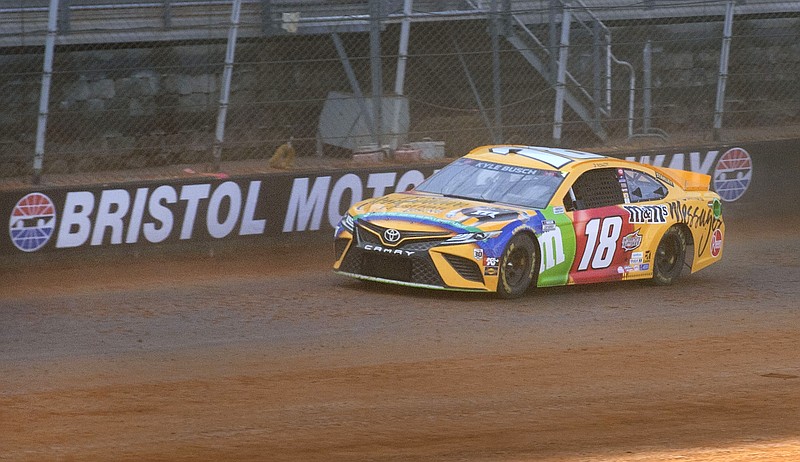BRISTOL, Tenn. - Kyle Busch took a long pause to carefully choose how to describe visibility Friday in the first practice on the dirt at Bristol Motor Speedway.
"So far better, I guess?" the veteran Joe Gibbs Racing driver said. "But second half of that practice, you couldn't see. You put one car in front of you and you can't see. Two cars? You definitely can't see. That's going to be the toughest part, the dust."
NASCAR brought the Cup Series back to the Tennessee dirt for a second consecutive year as Speedway Motorsports again transformed its Bristol bullring, this time for a Sunday night race. It will be the first time NASCAR races on Easter in more than 30 years in a scheduling choice by Fox Sports to attract more eyeballs.
Last year at Bristol, in the first Cup Series race on dirt since 1970, the results were mixed. The 30,000 tons of red Tennessee clay used to cover the concrete made the 0.533-mile track a dust bowl that had dangerously poor visibility when combined with the glare of the sun.
"We have to race at night," said Team Penske's Joey Logano, the winner of last year's race. "That was important. Because you just couldn't even see the cars, and it was unsafe inside the car."
Speedway Motorsports has made changes to the track as well, knocking 3 degrees of banking off to make it 16 degrees at the apron; the track gets progressively steeper closer to the wall. It was done to create multiple racing lines and prevent too much rubber grinding into one slick lane.
Reigning series champion Kyle Larson, who drives for Hendrick Motorsports, continues to compete in dirt track racing outside of NASCAR competition. He believes more could have been done at Bristol - specifically, the removal of windshields - and that NASCAR is wasting its time running a pseudo dirt race and not adopting all of the elements that make the formula a fan favorite.
"If we're not going to take the windshields out, then why are we racing on dirt?" Larson said on SiriusXM NASCAR Radio. "We just shouldn't race on dirt if we're not going to take the windshields out and actually have a dirt race with moisture in the track and being able to produce a real dirt race. I feel like we're just wasting everybody's time a little bit and not giving the fans and competitors what we all deserve."
Larson and Richard Childress Racing's Austin Dillon last year were the two main drivers advising Bristol and NASCAR on track prep, and both have argued the dirt can't be watered down and made moist enough with the windshields because they'd become caked with mud. The dirt is instead watered just enough - and that creates the blinding dust the drivers complained about.
Scott Miller, NASCAR's senior vice president of competition, told SiriusXM NASCAR Radio this week that racing without a windshield - which NASCAR tried during a test of the Next Gen car on dirt with driver Stewart Friesen - is too risky.
"The windshield is a critical safety component of our cars," Miller said. "Highly developed laminate. Really resistant to intrusion of foreign objects. Until we can further vet the possibility of not using a windshield, (we're going to) stick with the safety element of what we've been doing."
Larson said NASCAR replaced the windshield at the test with chicken wire, and the mud that slipped through stung Friesen's hands as he drove.
"I would not have felt safe with what they had for testing," Larson said. "With them putting chicken wire in it, it probably didn't look like they worked on it very long, like maybe last minute. I feel like if they would've worked on it months ago, then they probably would've come up with something safer to put in to keep big things from coming in the cockpit."
The lack of dirt experience among Cup Series drives has led several to enter Saturday's Truck Series race for extra seat time.
Logano and Harrison Burton will drive for David Gilliland Racing, Dillon will drive for Young's Motorsports and Hendrick's Chase Elliott will drive for Spire Motorsports, which won last week at Martinsville Speedway with William Byron - who went on to win the Cup Series race for Hendrick two days later at the same Virginia short track.
Sunday's field will be set by heat races and the lineups will be done in a random draw. Drivers will get points to be used to set their starting position based on where they finish in the heats on a 10-to-1 scale. There is an additional point available for every position improved from where they started the heat to where they finished. Ties in overall points will be broken by owner points.
NASCAR will use double-file restarts but have the option to go single file for safety purposes. There will be no live pit stops, and teams can only change tires and add fuel during the stage breaks, which will be six minutes.
